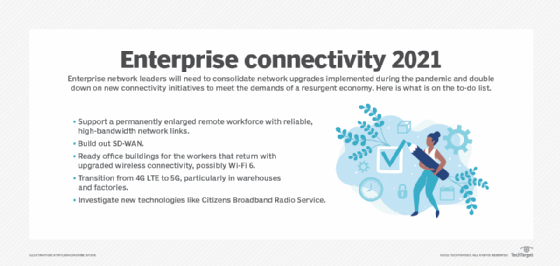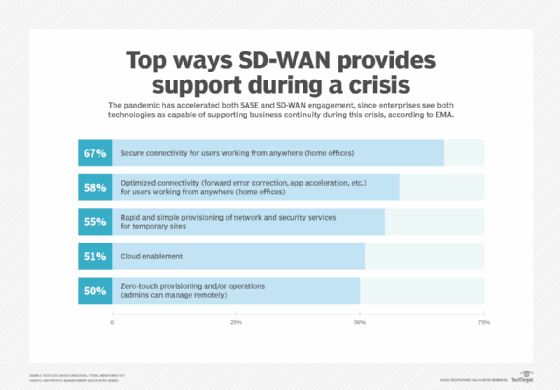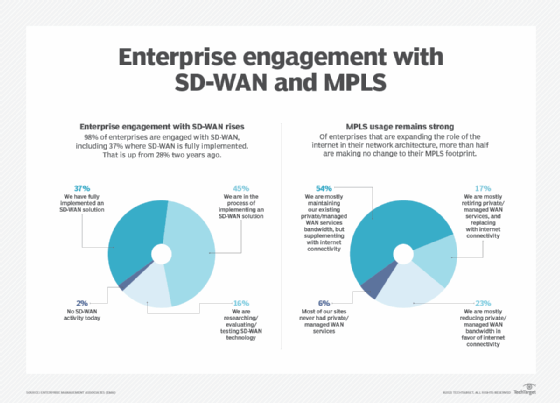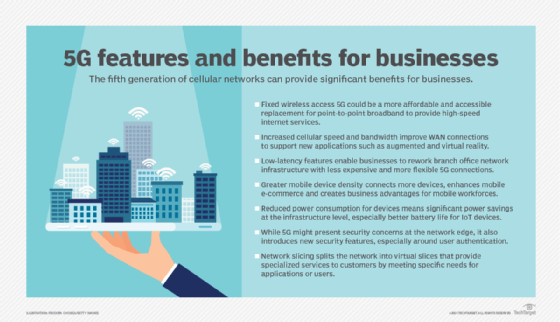Pandemic pushes enterprise connectivity to take a new path
COVID-19 delivered a connectivity shock to businesses. But savvy network execs were primed -- and are now showing the way forward in 2021 with SD-WAN, 5G and Wi-Fi 6.
If luck favors those who are prepared, Glenn Allison, vice president of technology and innovation for Tractor Supply Company (TSC) was both prepared and lucky in 2020 -- and is looking to capitalize on that good fortune in 2021.
When curbside pickup became de rigueur due to the COVID-19 pandemic, TSC was ready. Thanks to a major wireless technology upgrade deployed by the national chain in its more than 1,900 stores, TSC employees (called "team members") equipped with mobile devices could remain connected anywhere inside or outside the stores as they served customers. And social distancing in checkout lines? No problem. Team members with wireless card readers could check out customers anywhere inside or outside.
"COVID-19 accelerated our shift to digital," Allison said. In another stroke of good fortune, TSC, whose stores carry a wide range of rural lifestyle goods -- such as power equipment, feed, clothing and tools -- was deemed an essential business and remained open.
In the face of the pandemic, TSC opened 80 new stores, hired 10,000 new team members last year and is continuing full steam ahead in 2021, according to Allison.
Enterprise connectivity to-do list
TSC was particularly well suited to emerge from the pandemic with a strategic advantage, showing a path for others to follow. But whether leaders or followers, all companies face similar realities in 2021: more mobile and remote workers, office spaces that will regain relevance, customers who expect a great experience -- online or in-person -- and a future in which networks will need to carry more data than ever, particularly IoT data.
Enterprise network leaders will need to reinforce the changes forced upon them in 2020 and focus on new enterprise connectivity initiatives to meet the demands of a resurgent economy. Here are key items on the enterprise connectivity to-do list:
- enabling a permanently enlarged remote workforce to be highly productive, with reliable, high-bandwidth network links;
- building out SD-WAN implementations;
- readying office buildings for the workers that return with upgraded wireless connectivity, possibly Wi-Fi 6, and cubicles built for hoteling;
- transitioning from 4G LTE to 5G, particularly in warehouses and factories; and
- investigating and implementing new technologies like Citizens Broadband Radio Service where appropriate (see "CBRS fills wireless niche.")
Redefining IT in a Post-Pandemic World
If this pandemic has taught us anything, it is that we need to be and can be more resilient and flexible. Here is a compilation of stories that tackle how to seize opportunities for growth and change, responding to new customer expectations, building collaboration in the workplace, and supporting the office of the future.
Download now
The path forward will be different for every company, however, and fraught with variables that will be difficult to weigh. For example, the size and duration of the inevitable business rebound are impossible to predict and could vary widely from industry to industry. For many companies, an approach of watchful readiness, in which new technologies are deployed incrementally, will position those organizations to move quickly when opportunities arise.

Software-defined WAN finds traction during the pandemic
SD-WAN, which uses software to manage network traffic across a wide-area network or WAN, proved to be foundational to the path forged by radiology services provider SimonMed during the pandemic.
Having implemented an SD-WAN architecture in 2019, SimonMed CIO Duleep Wikramanayake pre-configured SD-WAN routers and shipped them to 150 of the company's 200 radiologists so they could work remotely. Because the radiologists could simply plug in the device and get up and running quickly all by themselves, they called Wikramanayake's shipment the "magic box."
"COVID was the catalyst," Wikramanayake said. "We had introduced SD-WAN and we realized we could do a lot of other things. … When things closed down, we went all out for digital transformation."
SimonMed's magic boxes have direct internet access connections for SD-WAN that carry picture archiving and communication system medical images. The large X-ray, MRI, ultrasound, CT-scan and video files require significant bandwidth, which the SD-WAN connections can handle. The routers in a box also include a broadband connection for applications such as Microsoft Office.
The sudden shift to remote work en masse -- although it necessitated some 24x7 work for his team -- was fortuitous for SimonMed, which is based in Scottsdale, Ariz. "Our MPLS voice and data costs were $5.4 million. Our costs are now about $2.1 million. We grew by 50% and dropped our costs by over 50%," Wikramanayake said.

SimonMed was not alone in pulling the lever on SD-WAN. The approach to managing network traffic has been gaining momentum in recent years and was accelerated by the pandemic. In a recent report, research firm Enterprise Management Associates (EMA) found that almost 98% of enterprises are engaged with SD-WAN in some way, and 37% have fully implemented SD-WAN.
"Enterprises are counting on the technology [SD-WAN] to improve security, enhance operational visibility, optimize performance, enable cloud connectivity and reduce overall complexity," the report stated.
But EMA also found that MPLS is not fading away. Of enterprises that are expanding the role of the internet, more than half are making no change to their use of MPLS, according to the consultancy.
 Lee Doyle
Lee Doyle
"SD-WAN tends to be pricey, and you get into scale issues. Not everyone needs it," said Lee Doyle, principal analyst at Doyle Research.
Cost appeared to be a factor in enterprise SD-WAN deployments during the pandemic, said Shin Umeda, vice president at research firm Dell'Oro Group. "In 2020, SD-WAN was used for a small number of remote workers -- generally people with very high-value job functions that have specialized applications that require secure and reliable connectivity," he said. However, costs are declining as SD-WAN vendors increasingly target remote-work implementations, opening the door for larger deployments, he added.
FordHarrison LLP, a multistate law firm based in Atlanta, is blending SD-WAN and virtual desktop infrastructure (VDI) technology to enable its attorneys to work remotely. Like SimonMed, FordHarrison had just completed a move from MPLS to SD-WAN when the pandemic struck. It was a sensible move, since the firm was able to eliminate the need -- and cost -- of a full-time engineer to manage 25 Cisco routers that handled voice and data traffic across the firm's MPLS network. In the wake of the COVID-19 outbreak, the new networking strategy shifted into high gear.

"When COVID hit, we sent almost the entire workforce home in March 2020," said Scott Shaw, CTO at FordHarrison. Although all attorneys could work remotely before the pandemic, no more than 50 were typically connected at one time. Overnight, 300 lawyers needed reliable, high-bandwidth and low-cost connectivity, so they could share large numbers of documents, including very large files. "They were able to [share them] with no lag and no drag. It just worked," Shaw said.
 Scott Shaw
Scott Shaw
Attorneys working from home use Microsoft Windows Virtual Desktop and Microsoft Remote Desktop Gateway through their ISP's connection. From their VDI workstations, the attorneys are connected to the nearest of the firm's 25 local offices. From there, an SD-WAN connection carries data to and from the firm's data center in Atlanta. An SD-WAN router in a box would be overkill for the firm's attorneys, but not so for the firm's CFO, for whom Shaw has configured such a device.
Looking forward, Shamus McGillicuddy, vice president at EMA, sees SD-WAN technology converging with SASE, Secure Access Service Edge, a zero-trust cybersecurity blueprint developed by Gartner in which edge devices are connected and secured via cloud-based services.
"SD-WAN will be an application on a SASE platform for cloud-based security due to the shift toward work from anywhere, whether home or office, to provide a secure remote connection for remote workers," McGillicuddy said.
Back at the office, Wi-Fi 6 is ready for its close-up
With offices largely deserted in 2020, some organizations have moved ahead with upgrades to their Wi-Fi networks, in some cases implementing Wi-Fi 6.
"The lack of employees in the office makes it a good time to plan for the eventual return of employees," noted Tam Dell'Oro, CEO of Dell'Oro Group.
But the workforce will neither be as large as before, nor will it come into the office as often. Look for workers to appear at the office only once or twice per week, according to Doyle, and when they are there, they likely will occupy any available space, rather than have their own office or cubicle. "Mobile employees are coming in and hoteling for a few hours. They will need a wireless connection -- that will be Wi-Fi 6," he said.
 Glenn Allison
Glenn Allison
That's the approach taken at TSC, where Allison has implemented Wi-Fi 6 at the corporate office in Brentwood, TN, which the company calls its Store Support Center. "We have been modernizing that building in response to COVID," Allison said. "Work at the Store Support Center has been primarily remote, but we modernized it with Wi-Fi 6 in advance of everyone's return," he explained.
To enable social distancing during the pandemic, TSC reduced the number of cubicles by half, from 1,200 to 600, and installed protective glass. However, the Store Support Center was already ahead of the game when it came to meeting the rigors of the pandemic, thanks to the use of wireless technologies, according to Allison. "It's not a traditional wired network. We're reliant on Wi-Fi for notebooks and video conferencing. It's a contactless office. When you swipe your badge, doors open automatically so you don't have to touch anything," he said.
When employees do go into the office post-pandemic, they'll expect plenty of bandwidth to support multimedia collaboration with their remote peers, Dell'Oro said. That will require better network intelligence to assist with capacity planning and space monitoring, as well as improved management to handle the network needs of the distributed workforce, the analyst said.
 Rick Belsky
Rick Belsky
In the new normal, some offices might need to accommodate periodic workforce surges during special meetings. At Liberty Mutual Insurance, vice president and senior director of technology Rick Belsky envisions occasional congregations of large numbers of employees, all of whom will need seamless wireless access with low latency and a high level of security. "Wi-Fi 6 addresses these needs well," Belsky said.
5G gains momentum
2021 is also shaping up as a year in which 5G networks take hold. Large factories, with many mobile workers, robots and assembly lines are well suited to the mobility, high-bandwidth and security that 5G delivers.
While big manufacturers dive in, many mainstream businesses are getting their toes wet in advance of the next wave.
"Almost half -- 45% -- of enterprises are looking at or using 5G," McGillicuddy said. "5G is probably the way to go for a factory, but this is not the year for mainstream adoption."
Among mainstream organizations, those that have implemented a private 4G LTE network are in the best position to upgrade those networks to 5G because they already have a commitment to a private wireless cellular network.
That's the strategy at TSC. Although the retail chain does not run massive factories, the company does have large stores with many items kept outside on side lots. As such, the chain's retail outlets are good candidates for 4G LTE and 5G. According to Allison, hundreds of TSC stores currently use Cradlepoint technology for 4G LTE internet connectivity and are poised for upgrades to 5G.
"I think 5G will be a game changer technology for us. We're embracing it," Allison said.
For its part, SimonMed maintains five mobile radiology units that transmit images via 4G LTE. Wikramanayake said he has been discussing upgrading those links to 5G with Verizon.
CBRS fills wireless niche
Companies interested in moving to 5G from 4G LTE might consider implementing Citizens Broadband Radio Service (CBRS).
CBRS is 3.5G Hz spectrum that, although set aside for the U.S. Navy, has been little used, particularly in regions not near Naval installations. CBRS has proven attractive for 4G LTE deployments and could also prove attractive for 5G as the OnGo Alliance has completed its 5G specifications for CBRS in the U.S.
 Tam Dell'Oro
Tam Dell'Oro
Andreas Müller, head of communication and network technology at Bosch, sees CBRS as an important enabler of 5G. "Thanks to changes in spectrum regulation, for example with CBRS in the United States, … enterprises can also deploy for the first time private 5G networks if desired, even without an established mobile network operator," Müller explained.
"Enterprises should consider this option [CBRS], particularly if there is a high-value application like video," said Tam Dell'Oro, CEO of Dell'Oro Group. "Deploying video surveillance, or video conferencing, over the existing wireless LAN network will not only degrade the entire performance of the network, but the performance on the cameras will be lousy," she explained. With CBRS in the mix, "enterprise wireless networks will become a collage of technologies -- the technology that is best suited for the application," the analyst predicted.
Factories gear up for private 5G
2021 will be the year that large manufacturers outfit many of their factories with private 5G networks. Bosch, General Motors and Ford have all announced major 5G initiatives as they seek to gain high bandwidth, mobility, IoT connectivity and tighter security.
"5G is more than yet another wireless technology. It represents a highly flexible and powerful innovation platform," said Andreas Müller, head of communication and network technology at Bosch.
In the quest to realize so-called "Industry 4.0," in which robots, self-driving forklifts, augmented or virtual reality glasses and drones will all play big parts, 5G will be indispensable. The ability to build a factory without wires or cables will enable manufacturers to move equipment, reconfigure robots and rearrange assembly lines without the encumbrance -- and expense -- of a wired infrastructure. Although Wi-Fi and 4G LTE confer these same wireless benefits, 5G is up to 100 times faster than 4G LTE and better suited to industrial applications than Wi-Fi, according to Müller.
"Wi-Fi is a perfect technology for many non-critical applications, whereas 5G has clear advantages in terms of dependability, latency, reliability and QoS [quality of service] in general," Müller said.

Network slicing: A building block of 5G systems
5G also includes advanced features such as network slicing, which permits several independent logical networks to run on the same physical network. One slice could handle AR/VR traffic, while another could handle connectivity for robots, for example. Network slices can also be allocated to increase bandwidth where bottlenecks occur.
 Andreas Müller
Andreas Müller
"We have been analyzing the potential of network slicing for quite some time and consider it as an important building block of a 5G system," Müller said.
Although most current 5G equipment offers very limited support for network slicing, Müller said, Bosch is looking forward to implementing many "micro-slices" in its 5G factory networks, with each slice carrying traffic for different purposes, such as robot control, sensor monitoring, and video inspection. "Network slicing can help to separate [each application] and to assure that end-to-end QoS requirements for all of them are met," he said. In addition, slicing can be used to create secure, isolated virtual networks, permitting third parties to gain secure access to part, but not all, of the factory network, Müller explained.
In addition, Müller said recent advances in the Open radio access networks (Open RAN) initiative will help bring 5G to campus networks by virtualizing and disaggregating the RAN element of 5G architecture. A key mover in this area is the O-RAN Alliance.
"There are many important developments going on at the same time with truly disruptive potential, which should not be missed," Müller said. Indeed, the feverish activity on multiple 5G fronts is likely to foster eagerly awaited innovation as wires disappear and intelligent IoT devices communicate. As 5G enters the mainstream, Industry 4.0 will follow in its wake.
The road from here: Consolidate gains, move ahead
With increasing vaccine availability now seeming to point the way out of the crisis inflicted by the pandemic, enterprise network leaders face the need to consolidate gains and build on progress -- or retake the initiative with new investment. The companies profiled here are doing just that.
For a company like TSC, which not only survived the shift to remote work and locked down customers but grew its business, 2021 presents the opportunity to build on momentum.
"We are much better positioned going into this year," Allison said. By the end of 2020, the retailer's 1,900 stores had completed wireless upgrades, with each receiving a 60% increase in Aruba 802.11ac access points. TSC's wireless network carries voice as well as data. Each team member gets a voice-enabled Theatro wireless digital communicator, a clip-on mobile device with an earpiece and microphone. The devices enable team members to assist each other wherever they happen to be in the store or on the grounds. Integration with the TSC customer mobile app enables a team member to receive an alert that a customer has arrived to pick up a curbside order.
"Many things we did last year were foundational. We're going to build on those and accelerate for more growth," Allison said. A major player in many rural communities, TSC is participating in the American Connection Project Broadband Coalition to boost connectivity for residents in remote locales.
 Duleep Wikramanayake
Duleep Wikramanayake
At SimonMed, Wikramanayake's team is optimizing the SD-WAN implementation with the expectation that radiologists will continue working remotely after the pandemic. "We will build on it [the magic box] in 2021 and get all our radiologists on it," he said. "The radiologists are the most expensive employees. If their efficiency can be improved by 10%, it might mean we would not have to add another radiologist, and our radiologists will be less stressed," Wikramanayake explained.
At FordHarrison, the big change for 2021 will be to implement Windows Virtual Desktop in Microsoft's Azure cloud, which will relieve Shaw's team from having to manage the VDI implementation themselves. To do that requires the implementation of a SilverPeak SD-WAN virtual appliance in Azure for connectivity to the Atlanta data center.
Bottom line
COVID-19, like many crises, has accelerated trends that were already happening. The past year proved that those who embrace new technologies can earn sometimes surprising dividends. And while no one is expecting 2021 to hold a shock the magnitude of 2020 -- no one was expecting COVID-19 either. Although predictions are hard, it's safe to say that opportunity will always favor those whose networks are prepared.









